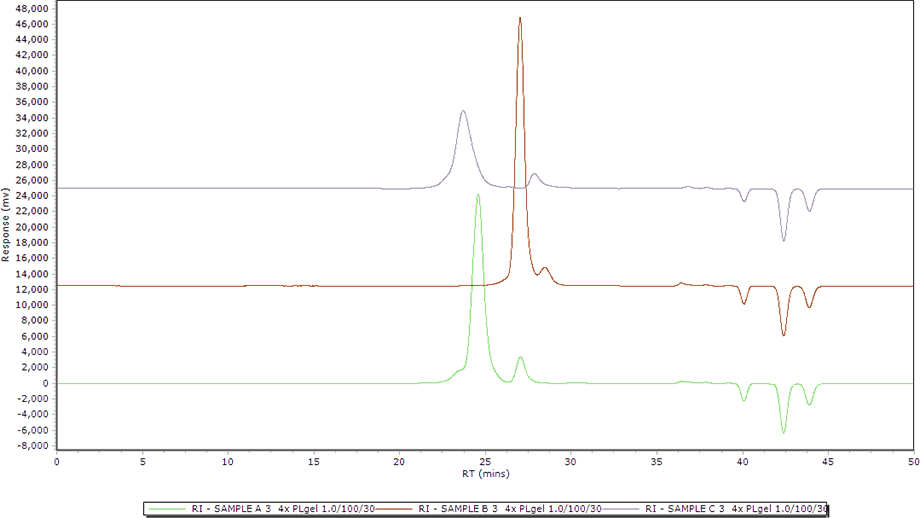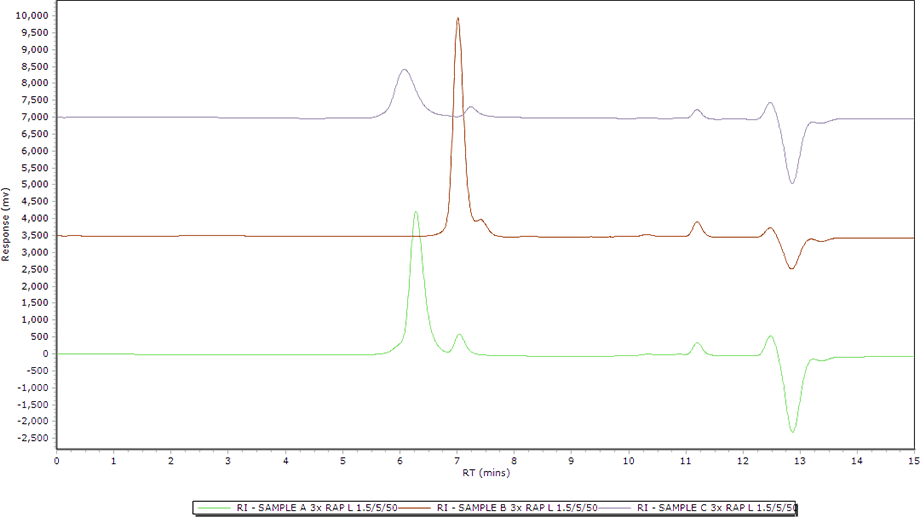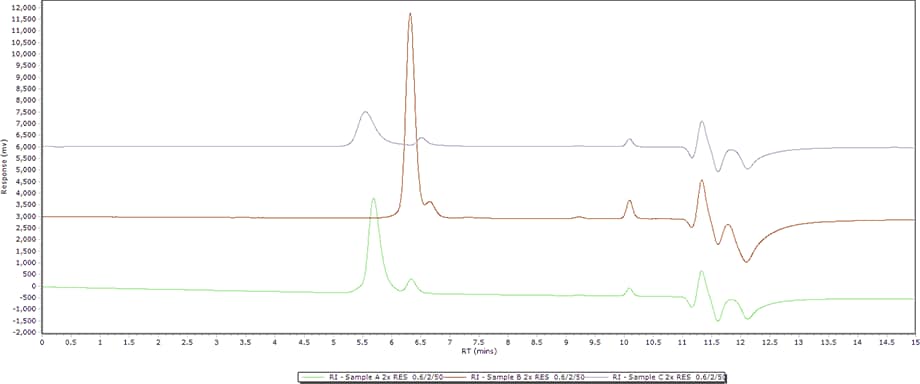Access Agilent eNewsletter, January 2015
>> Update My Profile | Subscribe to Access Agilent | Article Directory
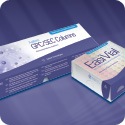
Faster, more economical GPC separations with Agilent solutions
By Stephen Luke
Agilent GPC Columns Product Manager
GPC is an important technique for determining the molecular weight distribution of a polymer and for comparing batch-to-batch polymer quality. GPC users are constantly seeking faster throughputs and higher quality. These demands must be balanced with the need to control costs, and buying new instrumentation may not be the answer. However, novel uses of conventional GPC instrumentation can deliver faster, cheaper separations.
Columns packed with particles having a high pore volume deliver significantly increased resolution compared to conventional GPC/SEC columns. Additionally, run times can be decreased by employing shorter column lengths and higher linear velocities, without sacrificing separation quality. Using industry-standard, highly cross-linked polystyrene/divinylbenzene (PS/DVB) particles with a 3-µm diameter maintain compatibility with conventional GPC instruments.
To demonstrate, we looked at three customer-supplied samples – believed to be Kratons (styrenic block copolymers consisting of polystyrene blocks and rubber blocks) – with two peaks in each sample (copolymer and homopolymer or diblock and triblock copolymers) and expected molecular weights < 400,000 g/mol.
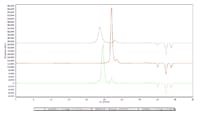 Enlarge
Enlarge
Figure 1. Three polymer samples run on four Agilent PLgel, 7.5 x 300 mm columns.
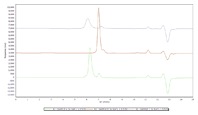 Enlarge
Enlarge
Figure 2. Three polymer samples run on three Agilent PL Rapide-L, 10 x 100 mm columns.
 Enlarge
Enlarge
Figure 3. Samples run on two Agilent ResiPore, 4.6 x 250 mm columns.
Deciding on the right GPC solution can be the difference in good, better, or best results
The original customer method used six individual porosity Agilent PLgel, 7.5 x 300 mm columns (10 µm 106, 2 x 5 µm 105, 5 µm 104, 5 µm 103, and 5 µm 500), with a run time of 70 minutes. In our conventional method, we opted to use four columns (Figure 1), with porosity of 103 to 106 as the lower pore diameter column and the duplication of 105 columns does not contribute to the separation. The mobile phase was THF, with a flow rate of 1.0 mL/min, column temperature of 30 °C, and injection volume of 100 µL. Standards were Agilent EasiVial PS-H with MW 162 to 6,000,000.
Faster GPC achieved with Agilent PL Rapide columns
The particles in Agilent PL Rapide columns have a very high pore volume to deliver significantly increased resolution compared to a conventional GPC/SEC column set. This delivers quicker run times, shorter column lengths, and better separations.
For faster GPC, we used a three-column set of Agilent PL Rapide-L columns to provide resolution over the expected sample molecular weight range (up to 400,000 g/mol), with a flow rate of 1.5 mL/min (Figure 2). Resolution was further improved by increasing column temperature to 50 °C and decreasing injection volume to 5 µL.
Taking GPC efficiency to the next level with Agilent PlusPore columns
We next selected Agilent PlusPore columns to go one step further. These columns also contain particles that have a very high pore volume. In addition, PlusPore columns are available in 4.6 mm id, which allow the use of lower flow rates and therefore less solvent. ResiPore columns, part of the PlusPore family, were chosen to provide resolution over the expected sample molecular weight range. The high efficiency, 3 µm particles used in ResiPore columns can be operated at higher linear velocities without sacrificing resolution, and so a two-column set was used with a flow rate of 0.6 mL/min to achieve resolution and keep run time to a minimum. The flow rate was 0.6 mL/min, column temperature was 50 °C, and injection volume was 2 µL. For this experiment, we used Agilent EasiVial PS-M standards, with MW 162 to 400,000.
Save time and money by choosing the right Agilent GPC solution
Agilent PL Rapide-L columns reduced analysis time by 70%, with a 55% saving in solvent costs (Table 1). The quality of results was maintained with the response ratio between resolved peaks and average molecular weight results consistent between conventional and fast GPC (within expected errors) (Tables 2 and 3). This increase in productivity and reduction in costs was achieved using a conventional GPC system.
Columns |
Run time (min) |
Saving (% run time) |
Flow rate (mL/min) |
Solvent (mL) |
Saving (% solvent) |
|---|---|---|---|---|---|
4 x PLgel |
50 |
0 |
1.0 |
50 |
0 |
3 x PL Rapide-L |
15 |
70 |
1.5 |
22.5 |
55 |
2 x ResiPore |
15 |
70 |
0.6 |
9 |
82 |
Table 1. Comparing costs of the different methods.
Mp |
Mn |
MW |
PD |
Mp |
Mn |
MW |
PD |
|
|---|---|---|---|---|---|---|---|---|
Sample A |
||||||||
|
Peak 1 |
Peak 2 |
||||||
Mean |
398198 |
373794 |
404895 |
1.08 |
106700 |
100498 |
103831 |
1.03 |
% RSD |
11 |
7 |
7 |
1 |
3 |
1 |
1 |
1 |
Sample B |
||||||||
|
Peak 1 |
Peak 2 |
||||||
Mean |
110262 |
107964 |
111181 |
1.03 |
56041 |
51015 |
53208 |
1.05 |
% RSD |
3 |
1 |
1 |
0 |
5 |
8 |
5 |
4 |
Sample C |
||||||||
|
Peak 1 |
Peak 2 |
||||||
Mean |
576906 |
472410 |
562185 |
1.19 |
74817 |
57671 |
66091 |
1.15 |
% RSD |
4 |
5 |
3 |
4 |
4 |
5 |
2 |
6 |
Table 2. Comparing MW results for all samples.
Columns |
Tr (Peak 2) |
Rs |
N/m (Peak 2) |
α |
Area (%) |
Height (%) |
|---|---|---|---|---|---|---|
Sample A |
||||||
4 x PLgel |
27.04 |
2.23 |
10612 |
1.10 |
10 |
12 |
3 x PL Rapide-L |
7.04 |
1.88 |
20277 |
1.12 |
10 |
13 |
2 x ResiPore |
6.34 |
1.90 |
13764 |
1.11 |
11 |
13 |
Sample B |
||||||
4 x PLgel |
28.46 |
1.22 |
5653 |
1.05 |
8 |
7 |
3 x PL Rapide-L |
7.41 |
1.13 |
23727 |
1.06 |
7 |
7 |
2 x ResiPore |
6.66 |
1.10 |
14510 |
1.05 |
8 |
8 |
Sample C |
||||||
4 x PLgel |
27.85 |
2.87 |
10292 |
1.17 |
11 |
16 |
3 x PL Rapide-L |
7.24 |
2.15 |
19130 |
1.19 |
12 |
18 |
2 x ResiPore |
6.52 |
2.10 |
11370 |
1.17 |
16 |
21 |
Table 3. Comparing separation and percentages for all samples.
Agilent ResiPore columns reduced analysis time by 70%, with an 82% saving in solvent costs (Table 1). Again, the quality of results was maintained (Tables 2 and 3). This further reduction in costs was also obtained with a conventional GPC system.
Agilent provides GPC/SEC solutions for all polymers
Discover the clear advantage of Agilent GPC/SEC columns, standards, and instruments for the analysis of all of your polymers – natural and synthetic. These solutions deliver fast, high performance separations that cover a wide range of applications in organic and water-based solvents.
There’s also a new and informative GPC wall chart – Achieve more with the polymer analysis people. Why not order your free copy today, and download a free copy of the new Fast GPC flyer, too. You can also use our online selection tool – the LC Column Navigator – to quickly find the right GPC columns for your particular application.
>> Update My Profile | Subscribe to Access Agilent | Article Directory
